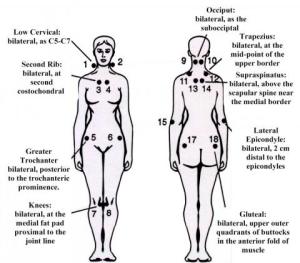 Definition of Fibromyalgia
Definition of Fibromyalgia
Fibromyalgia is a chronic pain disorder associated with multiple tender points, extreme fatigue and sleep disturbance. It is a very common disorder affecting about 5 million people in the United States, according to recent findings published by the US National Library of Medicine and the National Institute of Health.
Children, men and women can be diagnosed with fibromyalgia however it is more prevalent among women. Unlike many other disorders, fibromyalgia is similar to a syndrome.
A syndrome is defined by the National Fibromyalgia Association as a “collection of signs, symptoms and medical problems that tend to occur together but are not related to a specific, identifiable cause.”
People diagnosed with fibromyalgia suffer many symptoms, though the cause of fibromyalgia is still unknown. Much research has been done to understand the disorder.
Symptoms
According to Mayo Clinic, the symptoms of fibromyalgia are as follows:
- Pain
- Fatigue
- Sleep Problems
- Tender Points
- Numbness in hands and feet
- Headaches/Migraines
- Sensitivity to light and sound
 Along with these primary symptoms, some may experience other symptoms including:
Along with these primary symptoms, some may experience other symptoms including:
- Diminished attention span
- Tingling sensations in the hands and feet
- Sensitivity to heat or cold
- Stiffness
- Cognitive problems (known as “fibrofog”)
- Mood swings
- Depression
- Anxiety
- Stress
- Cramping
- Muscle spasms and twitching
- Bowel disturbances
- Anger
- Restless leg syndrome
- Poor balance
- Weight gain
 The combination of widespread pain, extreme daily fatigue and occasional sleep disturbance can be very debilitating and may hinder in everyday activities.
The combination of widespread pain, extreme daily fatigue and occasional sleep disturbance can be very debilitating and may hinder in everyday activities.
The pain from fibromyalgia has been described as sharp, throbbing and aching pain felt in the muscles and tendons of the body. Factors that can intensify the pain include:
- weather conditions
- physical activity
- lack of sleep
- stress.
Fatigue from fibromyalgia lasts for an extensive period of time. The lingering feeling of exhaustion can interfere with personal and social activities. According to the National Fibromyalgia Association, it states:
“During sleep, individuals with fibromyalgia are constantly interrupted by bursts of awake-like brain activity, limiting the amount of time they spend in deep sleep.”
People who have sleep problems from fibromyalgia have trouble falling asleep and can suffer from sleep disorders such as sleep apnea.
Diagnosis
The process of diagnosing fibromyalgia may be very difficult due to the fact that there are no laboratory tests present to diagnose the disorder. It can take up to five years to properly diagnose the disorder. The vast array of symptoms overlaps with other disorders and syndromes. A patient must meet certain diagnostic criteria to be diagnosed with fibromyalgia. A full medical history is needed to understand the history of the symptoms.

Fibromyalgia test diagnosis is made by determining the number of pain “tender points” that are sensitive to touch using the WPI scoring method.
Your doctor may perform a physical examination to test for specific tender points on the body. Your doctor may also want to perform blood tests to rule out the possibility of other diseases and disorders that may cause frequent pain and fatigue.
In 2010, the American College of Rheumatology created the “widespread pain index” (WPI) and a “symptom severity” (SS) scale. These new guidelines for diagnosing fibromyalgia include the following criteria:
- A WPI score of greater than or equal to seven
- An SS score of greater than or equal to five
- Symptoms have been present for at least three months
Physicians using the WPI scoring method will document the number of areas in which the patient has felt pain over the past week. The score will be between zero and 19, and the physical areas evaluated include:
- Left shoulder girdle
- Right shoulder girdle
- Left hip (buttock, trochanter)
- Right hip (buttock, trochanter)
- Left jaw
- Right jaw
- Left upper back
- Right upper back
- Lower back
- Left upper arm
- Right upper arm
- Left upper leg
- Right upper leg
- Left chest
- Neck
- Right abdomen
- Left lower arm
- Right lower arm
- Left lower leg
- Right lower leg
Physicians will evaluate and record the severity of pain for each of the areas using the following SS scale:
- 0 = No problem
- 1 = Slight or mild problems, generally mild or intermittent
- 2 = Moderate number of symptoms present at the moderate level
- 3 = Great deal of symptoms present
Treatment
Patients with fibromyalgia understand that living with the disorder means changing their lifestyle to decrease the symptoms and increase quality of life. To manage the pain associated with fibromyalgia, pain relievers such as Tylenol and Advil may be taken. Regular exercise may help reduce pain and stiffness. Patients should make an effort to improve sleep habits by going to bed and waking up at the same time every day.
Alternative Treatments
Take the time to speak to your doctor about which treatments might be appropriate for you. The following treatments may be considered:
- Taking vitamin D and magnesium supplements may help improve symptoms associated with chronic pain disorders.
- According to the Journal of Rheumatology, acupuncture therapy, based on ancient Chinese medical practices, has been shown to be effective in relieving fibromyalgia pain.
- A regular practice of therapeutic massages has been used by many fibromyalgia patients to treat muscle tightness and pain.
- Melatonin supplements are used by fibromyalgia patients to promote sleep.
- According to research published in the American Journal of Medicine, deconditioning from lack of physical activity aggravates the symptoms of fibromyalgia. Conversely, exercise helps decrease fibromyalgia symptoms.
- The American Journal of Lifestyle Medicine reported that Pilates, yoga, and resistance training have shown favorable results for patients with fibromyalgia.
- Studies have shown that biofeedback can be effective in reducing and controlling fibromyalgia pain.
- Cognitive behavior therapy has been used with fibromyalgia patients and resulted in substantial improvement in pain coping skills as well as reducing depression.
Resources
National Fibromyalgia Association – About Fibromyalgia
Mayo Clinic – Definition of Fibromyalgia
WebMD – Treatment for Fibromyalgia
American College of Rheumatology Fibromyalgia Criteria
NCBI Pub Med. US National Library of Medicine National Institute of Health – Fibromyalgia Statistics
______________________________
 This article is written by Hang Pham, Monterey Bay Holistic Alliance Health and Wellness Educator. Hang Pham was born in Hoc Mon, Vietnam. She came to America in 1994, becoming a U.S. citizen in 2011. Hang graduated from Seaside High School with diploma and received her AA in General Studies from Monterey Peninsula College in 2011. She received her BA in Collaborative Health and Human Services from California State University Monterey Bay (CSUMB) in 2012. In addition to working as a volunteer staff with the Monterey Bay Holistic Alliance, she currently works as a Clerical Aid in the Human Resources Department of Salinas City Hall. To find out more about our Health Educators, or to apply as a Monterey Bay Holistic Alliance writer or volunteer, visit our website at www.montereybayholistic.com
This article is written by Hang Pham, Monterey Bay Holistic Alliance Health and Wellness Educator. Hang Pham was born in Hoc Mon, Vietnam. She came to America in 1994, becoming a U.S. citizen in 2011. Hang graduated from Seaside High School with diploma and received her AA in General Studies from Monterey Peninsula College in 2011. She received her BA in Collaborative Health and Human Services from California State University Monterey Bay (CSUMB) in 2012. In addition to working as a volunteer staff with the Monterey Bay Holistic Alliance, she currently works as a Clerical Aid in the Human Resources Department of Salinas City Hall. To find out more about our Health Educators, or to apply as a Monterey Bay Holistic Alliance writer or volunteer, visit our website at www.montereybayholistic.com
Disclaimer:
The Monterey Bay Holistic Alliance is a charitable, independent registered nonprofit 501(c)3 organization and does not endorse any particular products or practices. We exist as an educational organization dedicated to providing free access to health education resources, products and services. Claims and statements herein are for informational purposes only and have not been evaluated by the Food and Drug Administration. The statements about organizations, practitioners, methods of treatment, and products listed on this website are not meant to diagnose, treat, cure, or prevent any disease. This information is intended for educational purposes only. The MBHA strongly recommends that you seek out your trusted medical doctor or practitioner for diagnosis and treatment of any existing health condition.
Disclaimer:

